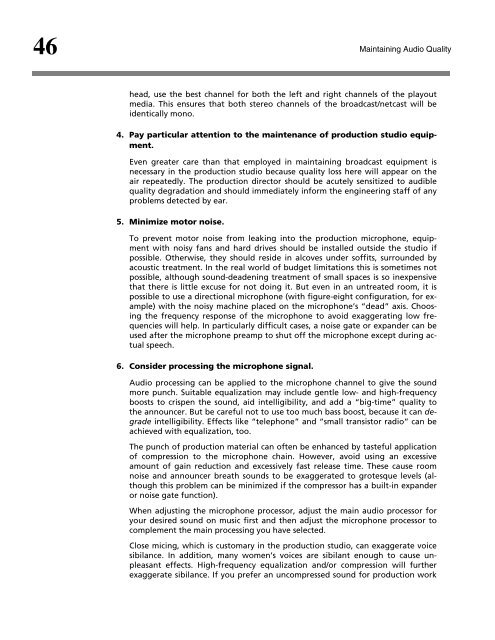Maintaining Audio Quality in the Broadcast Facility 2011 - Orban
Maintaining Audio Quality in the Broadcast Facility 2011 - Orban
Maintaining Audio Quality in the Broadcast Facility 2011 - Orban
Create successful ePaper yourself
Turn your PDF publications into a flip-book with our unique Google optimized e-Paper software.
46<br />
<strong>Ma<strong>in</strong>ta<strong>in</strong><strong>in</strong>g</strong> <strong>Audio</strong> <strong>Quality</strong><br />
head, use <strong>the</strong> best channel for both <strong>the</strong> left and right channels of <strong>the</strong> playout<br />
media. This ensures that both stereo channels of <strong>the</strong> broadcast/netcast will be<br />
identically mono.<br />
4. Pay particular attention to <strong>the</strong> ma<strong>in</strong>tenance of production studio equipment.<br />
Even greater care than that employed <strong>in</strong> ma<strong>in</strong>ta<strong>in</strong><strong>in</strong>g broadcast equipment is<br />
necessary <strong>in</strong> <strong>the</strong> production studio because quality loss here will appear on <strong>the</strong><br />
air repeatedly. The production director should be acutely sensitized to audible<br />
quality degradation and should immediately <strong>in</strong>form <strong>the</strong> eng<strong>in</strong>eer<strong>in</strong>g staff of any<br />
problems detected by ear.<br />
5. M<strong>in</strong>imize motor noise.<br />
To prevent motor noise from leak<strong>in</strong>g <strong>in</strong>to <strong>the</strong> production microphone, equipment<br />
with noisy fans and hard drives should be <strong>in</strong>stalled outside <strong>the</strong> studio if<br />
possible. O<strong>the</strong>rwise, <strong>the</strong>y should reside <strong>in</strong> alcoves under soffits, surrounded by<br />
acoustic treatment. In <strong>the</strong> real world of budget limitations this is sometimes not<br />
possible, although sound-deaden<strong>in</strong>g treatment of small spaces is so <strong>in</strong>expensive<br />
that <strong>the</strong>re is little excuse for not do<strong>in</strong>g it. But even <strong>in</strong> an untreated room, it is<br />
possible to use a directional microphone (with figure-eight configuration, for example)<br />
with <strong>the</strong> noisy mach<strong>in</strong>e placed on <strong>the</strong> microphone’s “dead” axis. Choos<strong>in</strong>g<br />
<strong>the</strong> frequency response of <strong>the</strong> microphone to avoid exaggerat<strong>in</strong>g low frequencies<br />
will help. In particularly difficult cases, a noise gate or expander can be<br />
used after <strong>the</strong> microphone preamp to shut off <strong>the</strong> microphone except dur<strong>in</strong>g actual<br />
speech.<br />
6. Consider process<strong>in</strong>g <strong>the</strong> microphone signal.<br />
<strong>Audio</strong> process<strong>in</strong>g can be applied to <strong>the</strong> microphone channel to give <strong>the</strong> sound<br />
more punch. Suitable equalization may <strong>in</strong>clude gentle low- and high-frequency<br />
boosts to crispen <strong>the</strong> sound, aid <strong>in</strong>telligibility, and add a “big-time” quality to<br />
<strong>the</strong> announcer. But be careful not to use too much bass boost, because it can degrade<br />
<strong>in</strong>telligibility. Effects like “telephone” and “small transistor radio” can be<br />
achieved with equalization, too.<br />
The punch of production material can often be enhanced by tasteful application<br />
of compression to <strong>the</strong> microphone cha<strong>in</strong>. However, avoid us<strong>in</strong>g an excessive<br />
amount of ga<strong>in</strong> reduction and excessively fast release time. These cause room<br />
noise and announcer breath sounds to be exaggerated to grotesque levels (although<br />
this problem can be m<strong>in</strong>imized if <strong>the</strong> compressor has a built-<strong>in</strong> expander<br />
or noise gate function).<br />
When adjust<strong>in</strong>g <strong>the</strong> microphone processor, adjust <strong>the</strong> ma<strong>in</strong> audio processor for<br />
your desired sound on music first and <strong>the</strong>n adjust <strong>the</strong> microphone processor to<br />
complement <strong>the</strong> ma<strong>in</strong> process<strong>in</strong>g you have selected.<br />
Close mic<strong>in</strong>g, which is customary <strong>in</strong> <strong>the</strong> production studio, can exaggerate voice<br />
sibilance. In addition, many women’s voices are sibilant enough to cause unpleasant<br />
effects. High-frequency equalization and/or compression will fur<strong>the</strong>r<br />
exaggerate sibilance. If you prefer an uncompressed sound for production work



![[PDF] Using the ITU BS.1770-2 and CBS Loudness Meters ... - Orban](https://img.yumpu.com/50629372/1/190x245/pdf-using-the-itu-bs1770-2-and-cbs-loudness-meters-orban.jpg?quality=85)






![[PDF] Optimod-FM Feature Comparison - Orban](https://img.yumpu.com/41741615/1/190x245/pdf-optimod-fm-feature-comparison-orban.jpg?quality=85)






